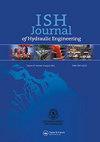基于机器学习分类器的洪水淹没建模
引用次数: 0
摘要
摘要:本文提出并评价了一种模拟洪水淹没区域的机器学习分类器,该分类器采用自适应神经模糊推理系统将模拟区域划分为洪水淹没区域和非洪水淹没区域。在数据驱动模型的训练过程中采用了粒子群算法。并将二维数值水力模型模拟洪水的结果用于训练和试验过程。然而,观测到的洪水的航空图像也可以使用。基于案例研究的结果,所提出的数据驱动分类器能够降低洪水淹没建模的计算复杂性,包括运行时间和CPU使用。该模型具有较高的可靠性和鲁棒性,可用于大洪水时最大洪水淹没图的生成。结果表明,所有测试的评估错误率均小于7%。建议在今后需要对最大淹没面积进行多次模拟的防洪工程中应用该方法。所开发的模型大大降低了工程中的计算成本。本文章由计算机程序翻译,如有差异,请以英文原文为准。
Flood inundation modelling by a machine learning classifier
ABSTRACT The present study proposes and evaluates a machine-learning classifier to simulate the flood inundation area in which adaptive neuro fuzzy inference system was applied to classify the simulated domain into flooded and non-flooded areas. Particle swarm optimization was utilized in the training process of the data-driven model. Moreover, the outputs of simulating floods by the two-dimensional numerical hydraulic model were used in the training and testing process. However, aerial images of observed floods could be used as well. Based on the results in the case study, the proposed data-driven classifier is able to reduce the computational complexities of the flood inundation modelling including runtime and CPU usage. The proposed model is highly reliable and robust for generating maximum flood inundation map in the major floods. The results indicated that the rate of incorrect assessment is less than 7% in all tests. It is recommendable to apply the proposed method in the future flood engineering projects in which numerous simulations of the maximum flooded area are required. The developed model considerably reduces the computational costs in the projects.
求助全文
通过发布文献求助,成功后即可免费获取论文全文。
去求助
来源期刊

ISH Journal of Hydraulic Engineering
Engineering-Civil and Structural Engineering
CiteScore
4.30
自引率
0.00%
发文量
59
 求助内容:
求助内容: 应助结果提醒方式:
应助结果提醒方式:


